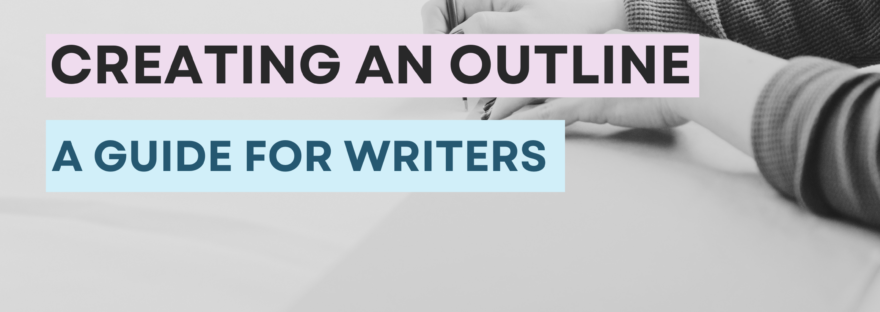Outlines aren’t just for large research projects. When you create an outline, you have a roadmap guiding you through the writing process. It helps you to stay on track and to organize your thoughts.
Whether you’re working on a blog post, letter to the editor, sales pitch, novel, or research project, creating an outline helps you to clarify your ideas, structure your content, and improve the flow and readability of your writing.
In this post, I’ll explore why outlines are essential, give you the steps for creating a helpful outline, and provide tips for creating effective outlines for all your writing projects.
Why Outlines are Important
Before you put your pen to paper (or fingers to the keyboard), it’s helpful to think about what you’d like to write – regardless of the type or length of your writing project. Here are five reasons why outlining before writing is beneficial.
1. Outlines help you organize your thoughts.
When you outline before writing, it helps you to organize your ideas and clarify your thinking. You can see how your ideas fit together and identify any gaps or inconsistencies in your project. Most outlines won’t be as extensive as the annotated outlines used for major research projects, but they can help you refine your ideas so that your writing is focused and coherent.
2. Outlines help you structure your content.
Outlines are to writing projects what blueprints are to architectural projects. An outline, even a quick one, helps structure your project. It helps you decide which order you’ll present your ideas in and helps you make sure that your readers understand the point you’re trying to make.
3. Outlines help improve the flow of your writing.
Outlines also help you ensure your writing flows nicely from one point to the next. They help you to stay on track and avoid getting bogged down in details. By writing with an outline, you’ll know where you’re going, where you’ve been, and how to cover the distance.
4. Outlines help you save valuable time.
If you want to avoid creating multiple drafts of your writing projects, outlines can help. You can avoid tangents or getting stuck by outlining your ideas and structuring what you’d like to say before you begin writing. A good outline also helps you to avoid writer’s block and get your ideas down on paper faster and more efficiently.
5. Outlines help facilitate collaboration with others.
If you work with others on your writing projects, you’ll find that outlines are particularly useful. Outlines help to ensure everyone is on the same page and working toward the same goals with your project. An outline can even help you divide tasks and delegate responsibilities so that you can integrate different perspectives into one document seamlessly.
An outline is a valuable tool for anyone needing to create written content. They help you organize your thoughts, structure your content, improve the flow of your writing, save time, and even collaborate with others. Once you know how to create an outline, you’ll find that it will become an essential step in your writing process.
Easy Steps to Create an Outline
The first time (or thirtieth) you look at a blank screen to create an outline, you may feel overwhelmed, but you don’t have to feel that way. Here are five simple steps to create a basic outline that will serve as the backbone for your writing project.
Step 1: Determine the purpose and scope of your writing project.
To keep your writing from meandering, you’ll need a clear idea of what you’d like to accomplish with your project. What are you trying to say or argue? Who is your target audience? How long will your project be? Knowing the answers to these questions will help you create an effective outline.
Step 2: Brainstorm and gather your ideas.
Once you have an idea of the purpose and scope of your project, it’s time to brainstorm. You can free-write about your topic, create mind maps, or even conduct preliminary research. This step aims to come up with as many ideas as possible without worrying about how you will organize or structure these ideas.
Step 3: Organize your ideas into categories and subcategories.
It may be tempting to skip step two and jump to step three, but don’t! The brainstorming process is an important part of being able to structure and organize your ideas. (You may also find that ideas that don’t fit in this particular project may make for a future project. Start organizing your ideas into categories and subcategories. This might involve grouping related ideas or creating headings and subheadings.
Step 4: Arrange your categories and subcategories into a logical order.
Now that you know what your categories and subcategories will be, you can arrange them into a logical order. This might be chronological order, or it might be the level of importance. The goal is to have an outline that flows from one idea to the next, guiding your reader through your writing project.
Step 5: Review and refine your outline as needed.
An outline is not an end-all-be-all piece of the writing process. Once created, review and adjust it as needed. This adjustment may come through developing new ideas, reorganizing ideas, or even making changes based on the feedback of others. You aim to have a final outline with a clear roadmap for your writing project.
Following these five steps, you will create an effective outline for any writing project, from a short blog post to a full-length novel. The key is to be flexible and open to revision and to keep your audience and purpose in mind throughout the process.
Tips for Effective Outlines
An outline is a great first step to creating a powerful writing style. It’s important to use your outline efficiently and consistently. Here are some tips for using outlines to improve your writing process:
- Don’t be married to your outline. Don’t be afraid to change your outline as you write.
- Use headings and subheadings that you’ll use when writing your project to help guide your readers.
- Keep it simple. Include only the most important ideas and details.
- Experiment with different formats. Try mind maps, flowcharts, or concept diagrams to find the best format for you and your writing project.
- Use active language. Active language helps you to communicate your ideas effectively.
- Use your outline as a reference tool. Once created, use your outline as a reference tool throughout the writing process.
- Consider creating short outlines for ideas when you record your ideas. This way, you can remember the angle you wanted to come at the topic from when you came up with the initial idea.
When you follow these additional tips, you can ensure that your outline is useful and improves your writing process. An outline can only benefit your work if you use it!
Whether you’re working on a school assignment, a professional report, or a personal project, an outline can be a valuable tool to help you stay on track and communicate effectively.
Do you have an outlining tip you’d like to share or an outlining tool you’d like to see reviewed on this blog? Post your comment below.

